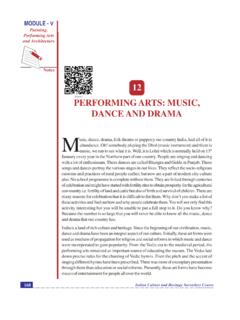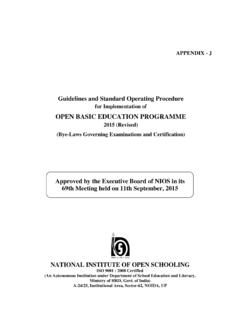Transcription of 8 RELIGION AND PHILOSOPHY IN ANCIENT INDIA A
1 RELIGION and PHILOSOPHY in ANCIENT IndiaNotes 111 Indian Culture and Heritage Secondary CourseMODULE - IVReligion andPhilosophy8 RELIGION AND PHILOSOPHY INANCIENT INDIAAs soon as November and December come in we find new calenders flooding themarket. Some calenders are very colourful. They are marked with different even have small pictures on the dates. They are holidays and we lookforward to them. You also look forward to them. Yes, they are religious festivals or nationalfestivals and INDIA has plenty of religions that are flourishing. Processions on the road,good food, clothes, gifts, people worshipping in their religious places, wishing each otheris a common sight. Yes, INDIA is a beautiful, lovely and a lively country to be in.
2 This isbacause RELIGION has always been a significant factor in influencing the lives of people inIndia from the earliest times. It would, indeed, be very interesting to study RELIGION in itsdiverse forms through the various stages of its growth. The relationship between religionand PHILOSOPHY has been an intimate one and hence their growth and development need tobe studied in an interrelated manner. In this lesson you will study about the development ofreligions and PHILOSOPHY in ANCIENT INDIA . OBJECTIVESA fter studying this lesson, you will be able to: explain the meaning of RELIGION ; identify the characteristics of various religions movements in ANCIENT INDIA ; explain the ideas of the six schools of Ved c PHILOSOPHY ; examine the role played by the Charvaka School; RELIGION and PHILOSOPHY in ANCIENT IndiaNotesIndian Culture and Heritage Secondary Course 112 MODULE - IVReligion andPhilosophy explain the Jaina theory of reality; examine the contributions of Buddhist PHILOSOPHY .
3 RELIGIONR eligion is the science of soul. Morality and ethics have their foundation on RELIGION . Religionplayed an important part in the lives of the Indians from the earliest times. It assumednumerous forms in relation to different groups of people associated with them. Religiousideas, thoughts and practices differed among these groups, and transformations anddevelopments took place in the various religious forms in course of time. RELIGION in Indiawas never static in character but was driven by an inherent dynamic system of PHILOSOPHY in INDIA is a quest for Truth, which is one and the same,always and everywhere. The modes of approach differ, logic varies, but the purposeremains the same trying to reach that Truth.
4 I am proud to belong to a RELIGION which has taught the world tolerance and universalacceptance .. We believe not only in universal toleration, but we accept all religionsas true. Swami Vivekananda at Parliament of world Religions in Chicago 1893 Indian spirituality is deeply rooted in ANCIENT philosophical and religious traditions of theland. PHILOSOPHY arose in INDIA as an enquiry into the mystery of life and existence. Indiansages called Rishis or seers , developed special techniques of transcending the sense andthe ordinary mind, collectively called yoga. With the help of these techniques, they delveddeep into the depths of consciousness and discovered important truths about the truenature of human being and the sages found that the true nature of the human being is not the body or the mind, whichare ever changing and perishable but the spirit which is unchanging, immortal and pureconsciousness.
5 They called it the Atman is the true source of human s knowledge, happiness and power. The rishisfurther found that all individual selves are parts of infinite consciousness which they calledBrahman. Brahman is the ultimate reality, the ultimate cause of the universe. Ignorance ofhuman s true nature is the main cause of human suffering and bondage. By gaining correctknowledge of Atman and Brahman, it is possible to become free from suffering and bondageand attain a state of immortality, everlasting peace and fulfillment known as in ANCIENT INDIA meant a way of life which enables a human to realize his truenature and attain and PHILOSOPHY in ANCIENT IndiaNotes 113 Indian Culture and Heritage Secondary CourseMODULE - IVReligion andPhilosophyThus PHILOSOPHY provided a correct view of reality, while RELIGION showed the correct wayof life; PHILOSOPHY provided the vision, while RELIGION brought about the fulfillment; philosophywas the theory, and RELIGION was the practice.
6 Thus in ANCIENT INDIA , PHILOSOPHY and religioncomplemented each other. May we hear that which enlightens our minds, may we see Divinity everywhere,may we feel the presence of the Almighty within us and all the actions of our bodiesand minds be in the service of that Almighty Being; may we have peace unending . (Rig-Veda 1-89) PRE-VEDIC AND VEDIC RELIGIONFrom the archaeological findings in the pre and proto-historic sites it seems that thesepeople believed in the sanctity of the creative force and venerated the male and femaleaspects of divinity. It appears that they were worshippers of the forces of nature like thesun and the moon. This belief is also partly substantiated by the early literature of theAryans. The nature of the religious beliefs and practices of the Aryans is also known fromthe Rig Veda, They believed in many gods like Indra, Varuna, Agni, Surya and , and ritual offering of food and drink to fire in honour of the Gods, constitutedthe main religious practices.
7 The Sama Veda and the Yajur Veda elaborated the differentaspects of the sacrificial acts and this ritualism was further elaborated in the Atharva Veda contained a great deal of animistic beliefs. The seers entertained doubtsabout the utility and efficacy of the Vedic ritualism. Polytheism was challenged bymonotheistic ideas and the various deities were introduced as different ways of namingone eternal Aranyaka and Upanishad sections of the Vedic literature envisage a progressive Upanishads, represent the early stage in the origin and development of the religions-metaphysical concepts which were used later by the religious leaders and reformers ofancient and medieval INDIA . Some of them followed the traditional lines while othersproceeded along the paths of unorthodoxy.
8 INDIA down the ages attempted to grapple with the fundamental problems of lifeand thought. PHILOSOPHY in INDIA began with a quest after the highest truth- truthnot as mere objective certitude, but as being closely linked with the developmentof personality and leading to the attainment of the highest freedom, bliss andwisdom. It demanded, therefore, not only a philosophical discipline of reasoning,but also a discipline of conduct and the control of emotions and passions. Thus the synthesis between deep philosophical analysis and lofty spiritual disciplineis an abiding feature of Indian PHILOSOPHY and its outlook is entirely different fromthat of western PHILOSOPHY . It is hoped that it will serve not only to make plain the spiritual aspirations of anancient nation, but also to show the relevance of those aspirations to the modernReligion and PHILOSOPHY in ANCIENT IndiaNotesIndian Culture and Heritage Secondary Course 114 MODULE - IVReligion andPhilosophyworld and thus forge a powerful link in the chain of human fellowship and universalconcord.
9 PHILOSOPHY in INDIA is not a product of speculation but of experience, direct andpersonal. A true philosopher is he whose life and behaviour bear testimony to thetruths he preaches. UNORTHODOX RELIGIOUS MOVEMENTSThe religious movements associated with persons like Mahavira and the Buddha in aboutthe middle of the first Millennium BC fall under this category. There were many othercreeds during this time as well. The creeds preached by some of them contained elementsthat were not in keeping with the Vedic tradition. They ignored the infallibility and supernaturalorigin of the Vedas. Unlike the Vedic seers who were Brahmin sages, many of these newteachers were Kshatriya. Both Buddhism and Jainism were atheistic creeds in the , Buddhism endorsed the doctrine of the Law of Karma and upheld the belief inrebirths of the embodied skandhas and the inevitability of suffering in the very existence ofbeings.
10 Many of these view points are also found in the major Upanishads. THEISTIC RELIGIONSC reeds of theistic character evolved almost simultaneously with the non-theistic important deities of these religions were not primarily Vedic ones but those that camefrom unorthodox sources. Influence of pre-vedic and post-vedic folk elements were mostconspicuous in their origin. The primary factor that motivated these creeds was Bhakti, thesingle-souled devotion of the worshipper to a personal god with some moral link. This ledto the evolution of different religious sects like Vaishnavism, Shaivism and Saktism, whichcame to be regarded as components of orthodox Brahminism. These sects in course oftime came to have a significant impact on the popular forms of Buddhism and Jainism.














